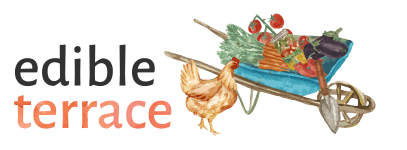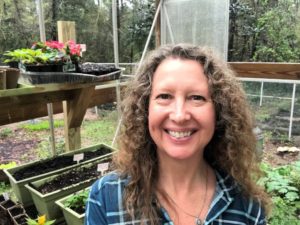Hey! By the way… TheEdibleTerrace is reader-supported. When you buy through links on our site, we may earn an affiliate commission and as an Amazon affiliate, we earn from qualifying purchases. Thanks in advance for your support!
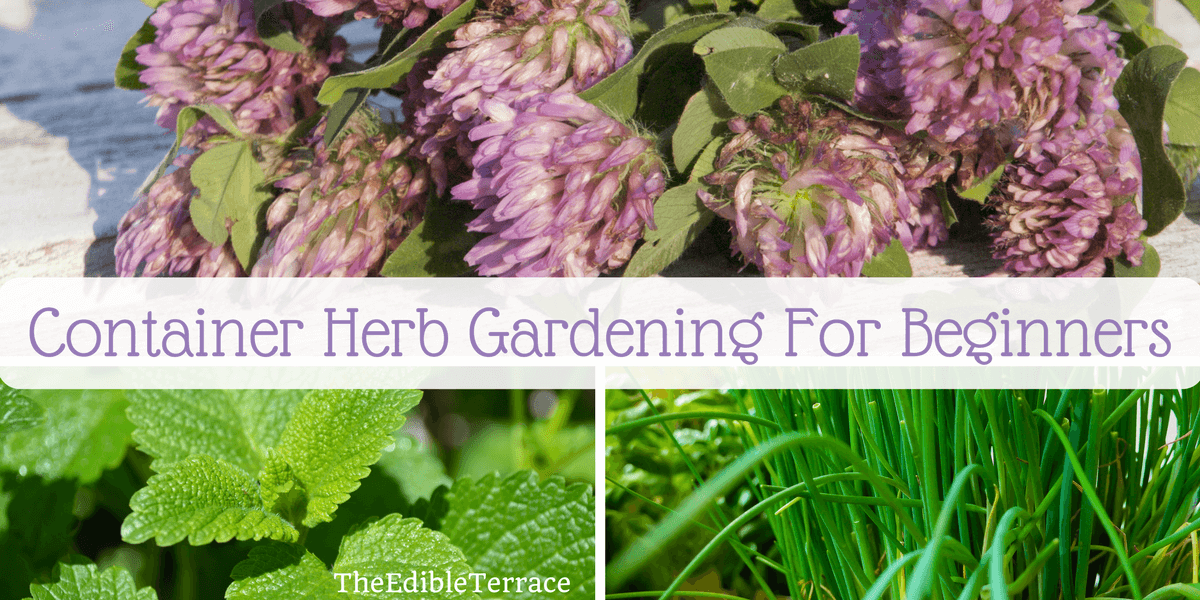
For those of you who love the idea of gardening but need something easy to start with, herbs are totally the way to go. You can grow them in small spaces, pots, raised beds, decks, etc. Beginners will be encouraged by how easy it is to grow many of these plants. Container herb gardening for beginners is possible and I will give you several tips, ideas and plans on how to get started.
One of the most appealing things anyone will learn about herb gardening is how relaxing and simple growing herbs can be. Discovering all the wonderful, various herbs and what they do is a captivating pastime, and can be quite beneficial. You can use herbs for cooking, as medicinal aids such as topical dressings or healthy teas, or simply for decorative plants around your home.
Easy Herb Gardening for Beginners
Decisions! Decisions!
There are so many herb plants to choose from though. It can be a bit daunting to those who are just starting out. Ponder what purpose(s) you are serving by growing this garden. Are you trying to liven up your cooking with fresh herbs (vs those dried out, flavorless ones from the store!)? Do you want to grow medicinal herbs to help your family? Are you trying to attract bees and other beneficial insects to your garden? Hmmm. What am I missing?
After you have made this decision, then space is probably your next consideration. How much space do you have in relation to the amount of herbs you want to grow? Do you want to grow them indoors? If so, check out my other article here on indoor herb gardening. Do you have a little space outside where you can grow your herb garden in pots?
How about growing your herbs in your front yard? Many herbs bloom and are quite beautiful so your neighbors who are not in the know will just think you are planting flowers (who are we to tell them differently!). Lavender and fennel both come to my mind but they are certainly not the only ones. The fun part of this is many of these flowering herbs also attract butterflies and bees.
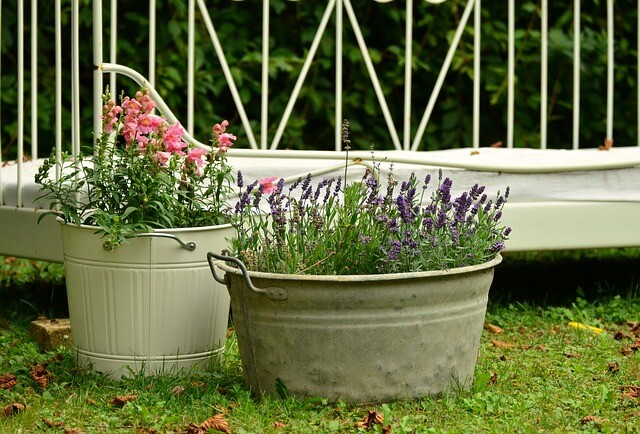
Another very important step is to confirm what your growing zone is. Go to the USDA’s website here and find out. http://planthardiness.ars.usda.gov/PHZMWeb/ İMuy importante!
You will want this information when you begin researching your herbs. Why? Some herbs can only grow in certain zones. For example, if you decide to grow mint (mojito anyone?!?), make sure you find one that will grow in your specific zone. For me, in zone 8b (an amazing growing zone, BTW) I can grow apple mint. If you are in one of the colder zones, you can still totally grow your herb garden, you just may need to shift your plants inside during your frostier times of year.
Seeds or Seedlings. The Big Question.
Next decision. Do you want to grow your herbs from seeds or seedlings? Pros and Cons.
Pros: You will save a lot of money by growing from seedlings. And there is nothing better than the satisfaction of knowing you grew THAT plant from its inception.
Cons: It is harder and takes longer. Some herbs, such as Rosemary, are notoriously hard to grow from seed. I can definitely relate here. I have tried growing many herbs from seed…and I have experienced many failures. Currently, I have some seedling fennel, tarragon and cilantro growing for me.
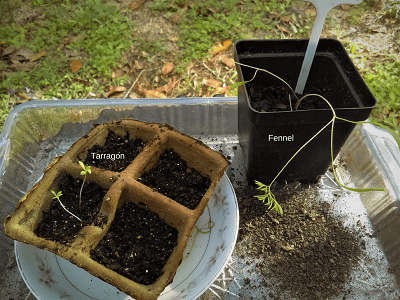
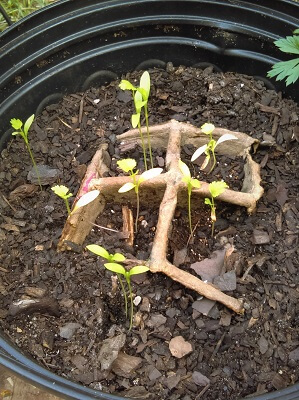
What is your timeframe?
Oh, and what time of year is it right now for you? Is it spring and the nurseries are advertising they have seedlings? Or is it cold and snowy outside and you are dyingtoseesomethinggreen?
If it is the latter, then buy some seeds online and start your own mini greenhouse in your living room. Try to put your seeds in your most sunny south facing window (or cheat and buy a plant grow light – we gotta do what we gotta do right?).
The nice thing about the mini greenhouse idea is it does not take up very much room. I have an article on how to start seeds here. The short of it is that I buy biodegradable seed starting pots (called peat pots), put organic seed starting mix in them (it is actually a mix that does not have soil but boy can it grow some seedlings!), plant the seeds and make sure those little pots stay watered and warm.
I have begun buying seeds from Seeds Now because their seeds are non-GMO and the site gives you SO much information on how to grow your plants. Valuable info to have!
After a couple weeks, you will begin to see your seedlings. So you do not lose track of what you planted (storyofmylife!), label everything really well. Sharpies, plant markers, etc.
Research The Herbs You Are Growing
Once your seedlings have grown at least two leaves (leaves that you recognize as those that belong to your plant) (clarification in pic below), they can safely be transplanted to a bigger pot.
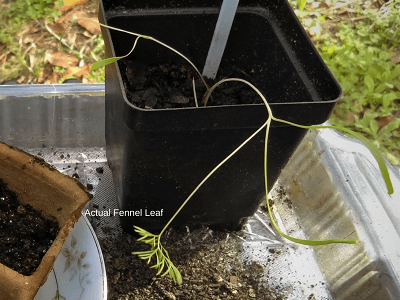
This is where you will want to do some homework on your particular plants. For example, some herbs can grow really tall. For example, my basil is monstrous and approx. 2ft high. My oregano totally took over its pot and almost killed the rosemary that it was supposed to be sharing a home with. However, oregano grows low and out – like a ground cover. My bay leaf tree can grow as high as 40ft (NOT a typo).
Additionally, some of your herbs will be more delicate than others (thyme comes to my mind) and you might want to be careful which other plants you pair it with. Small confession: I keep killing my thyme. Regardless whether I buy it as a seedling or try to grow from seed. I am trying once again right now. So far, so good!
Also, some herbs just do not grow well from seed (bay is one example) or they take a really long time to develop. If you’re up for the challenge, great! If not, maybe buy a mix of seeds and seedlings to get you started.
Growing Herbs Outside
Are you planning to grow your herbs outside? Then make sure you put them in a spot that gets approximately 6 hours of sun each day, preferably in an area with a south facing view. In other words, go to the south side of your lot, patio, etc. Does that area get 6-8 hours of sunlight or is it blocked by something? Your next two best locations are south or west facing. You do want some afternoon shade for your herbs as that is typically when the sun is at its strongest.
Beginner Container Herb Garden
Choosing Your Pots

Fortunately, most herbs do not need very deep soil to grow. The typical depth is 6-8 inches. Some of the taller plants such as fennel or dill will need around 10 inches of soil if you want them to thrive.
What containers should you choose? Anything you want! The mostest importantest part of this is that you make sure those pots have good drainage. If you find a container you like and it doesn’t have drainage holes then drill your own. I have done that on several occasions.
Watering Your Herbs
Many herbs cannot be overwatered (which I tend to do). I am pretty certain that is how I killed my thyme. This is where your diligent homework into how to grow your particular herbs will go a long way in making your garden a success.
That whole adage about sticking your finger in to see if the soil is moist has never worked for me.
Getting this cheap moisture sensor from Amazon made ALL the difference for me. No longer over watering. No longer underwatering. Etc.
When the dog days of summer hit, make sure you check your pots twice a day – especially if you have small ones. Your plants may be parched by then.
Choosing soil
This is another pretty important step. Since you are growing your herbs in pots, you need potting soil. The difference between plain old garden soil and potting soil is that potting soil has mediums such as perlite and peat moss added to it. These basically help mimic the structure of garden soil.
So, look for organic potting soil and while you’re out, pick up a bag of mushroom compost too. This will be your organic fertilizer. The ratio will be 1:1. Mix them together thoroughly in a large bucket or wheelbarrow before adding to your pots.
Before I put soil in my pots, I usually put a small layer of mulched leaves in the bottom – deep enough to cover the holes. This keeps my soil from falling out the holes when I water. If the pot is small enough, you could also put a coffee filter in the bottom.
An old pair of cut up pantyhose would also work (this idea comes from my free 101 Gardening Tips & Tricks ebook). You can check that out here.
Then, put the soil into your pots. Leave enough room at the top so that you can put your seedlings in and cover around them with enough soil to make it all even.
Companion Planting
This is where your creative self comes in. Are your pots big enough that you can plant several together and make a fun, attractive mix? Maybe you could theme it? Your Italian dish herbs can go in one pot and cocktail mixes go in another. Or, you can coordinate colors.
Remember some of your herbs can grow really tall. Can you layer?
A 12” container can hold approx. 3 to 4 plants and a 15” container can hold 5-6 successfully.
Do a little research to confirm the plants are compatible before making them roommates. For example, Farmer’s Almanac recommends we grow fennel all my its lonesome self. Or plant anise with coriander because the coriander promotes growth and germination.
Last (but probably most important), is that some herbs thrive in a dryer soil (I.e. you will water them less). A couple of these are sage, thyme and rosemary. These might all make great companion plants since they will all appreciate being watered less.
They’re Planted, Now What?
Keep an eye on them. Check their water religiously and inspect often for fungus or diseases. If you see a white powdery coating on the leaves, then it is powdery mildew.
You may notice insects on them. Some of these insects are beneficial so take care to check before pulling off.
Fertilizing
The mushroom compost should have your fertilizer covered for the first year. After that (or if you feel they need a little boost), add some liquid seaweed (follow the directions for exact measurements) which will give them a little boost of nutrients.
If it looks like your soil is shrinking with time, that is because the plants are feeding on the nutrients. Do not hesitate to add more mushroom compost.
Harvesting
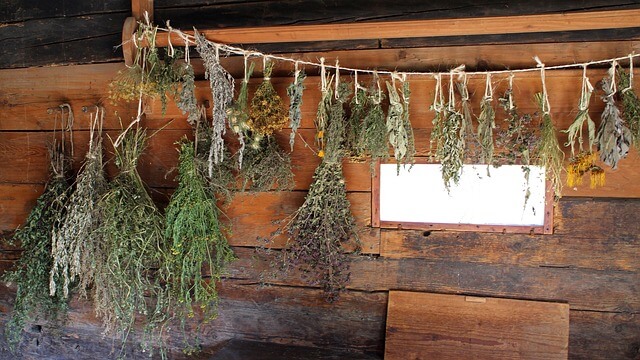
When you go to harvest your bushier plants such as oregano, cut from the top of the plant not the bottom. If you cut from the top, you will be encouraging them to grow fuller and bushier – vs tall and lanky. Cut just above another set of leaves to encourage new growth.
The plants that grow on long stems such as lavender, cut from the bottom.
I have an article here with more details on harvesting and drying herbs.
Frost Tolerance
Most herbs cannot tolerate frost so for those of you who experience such low temperatures, either cover your plants with Agfabric or bring them inside until the weather becomes more tolerable. If you don’t, I can virtually guarantee you that your herbs will be destroyed. I learned that the hard way!
List Of Herbs and Whether They Grow Well From Seeds or Not
| Herb | Grows Well From Seed | Notes |
| Basil | Yes | Buy a dwarf variety as this herb can grow to 3’ tall. 60-90 days to maturity. |
| Chives | Yes (faster to grow from seedlings though) | Gorgeous, unusual purple blooms. Grows to 12” tall. 80 days to maturity. |
| Coriander/Cilantro | Yes | 60 days to maturity |
| Cumin | Yes | Grows delicate white blossoms. 90 days to maturity. |
| Fennel | Yes | Can grow to 30” tall. 80 days to maturity. |
| Lemon Balm | Yes (can take 2 years to fully develop) | 75 days to maturity. |
| Marjoram (Sweet or Pot) | Yes | Pretty purple blooms. 90 days to maturity. |
| Oregano | Yes | 90 days to maturity. |
| Parsley | Yes | 60 days to maturity. Can take 3-4 weeks before you will see seedlings. |
| Rosemary | No | Grows best from cutting or seedling |
| Savory | Yes (seeds are slow to germinate) | Grows delicate light purple flowers. 65 days to maturity. |
| Tarragon | No | Also called Dragon Wort. Best to grow from cutting or seedling. Can grow to 2’ high. |
| Thyme | Yes | Very aromatic. 80 days to maturity. |
Conclusion
If you wanted to learn herb gardening, you came to the right place. By now you should have a thorough understanding of how to grow herbs in pots. Do you have questions? Did I leave anything out? Let me know in the comments and I will make sure and answer back. Container herb gardening for beginners is absolutely doable once you get a little information under your hat.
In reality, it is no different than growing any other plant. They just need a little of our attention and they will provide us with some seriously awesome culinary and herbal delights!
